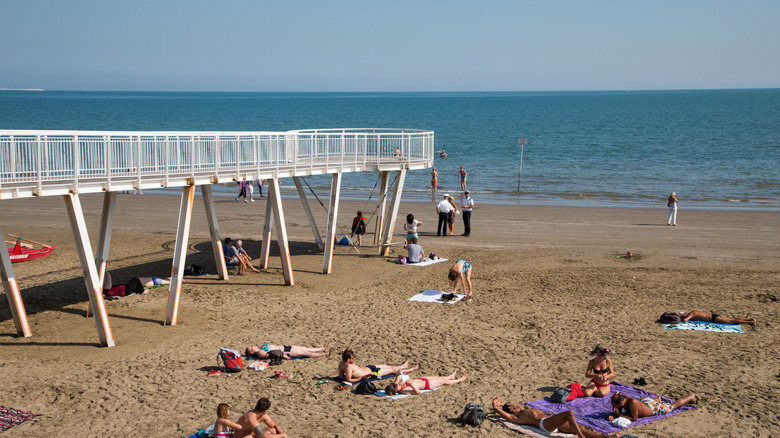Escape Large Venice Crowds At A Nearby Island With Serene Beaches And Vibrant Storied Streets
Venice is known for many things, and there are several reasons why it is on so many people's travel bucket lists. As one of the most beautiful and historically significant places in the world, it boasts stunning architecture, a unique culture, a rich history, and, of course, plenty of options for delicious meals. On top of that, the fact that Venice is slowly sinking also urges visitors to experience the City of Canals sooner rather than later. Unfortunately, this means it's likely to be extremely crowded, especially during certain times of the year. So what do you do? You should still see Venice, but we also recommend making your way to the gorgeous island of Lido to enjoy some seaside serenity.
Lido (or Lido di Venezia) is located just south of Centro Storico, the main island of Venice, wedged between the Venetian Lagoon and the North Adriatic Sea. Sadly, you cannot reach Lido by gondola. However, there are several other ways to go island hopping while visiting Venice. Naturally, the best way to get to Lido is by taking a vaporetto, which is a water bus that serves as the city's main transportation system. A trip on a vaporetto will take you to Lido for just a few euros in only about half an hour. It should be noted that the small island of Lido gets very busy during the high season when tourists and locals escape there for a day (or two) at the beach. But, considering Venice is a major tourist destination that receives around 20 million annual visitors, the crowds at Lido are much tamer.
Lido is home to Venice's best beaches
The seemingly unassuming island was once generally ignored by tourists but has since become a go-to beach destination in Europe for both visitors and locals, especially those looking to stay in a luxurious resort-style hotel. Many beaches, especially ones that are equipped with facilities, are private (meaning there is a fee to get in) or for resort guest use only. These include the beach in front of the Hotel Excelsior, San Nicolò Beach, Blue Moon, and Lungomare d'Annunzio Beach. At these private beaches — which essentially function as beach clubs — you can purchase an umbrella, lounger, and towel for the day. You will also be well situated to access plenty of cafes and eateries as well as changing rooms and sports areas. Since they're very convenient, you should expect to see some other tourists there.
There are also some free beaches on the island, but they can become crowded in the summer and are slightly harder to get to than the private ones. Alberoni Beach is the furthest south on the island and is a little wilder and less developed. You'll likely have to take a bus, which are allowed on land in Lido (unlike the lack of land transportation in Venice), and then walk past groves of trees and sand dunes to reach your destination. But once you arrive, you'll be greeted by beautiful sands and fewer crowds. The other free beach is Murazzi Beach, which is located in a slightly more convenient area closer to the center of the island than Alberoni. It is also comparatively uncrowded and natural.
Other things to do in Lido
But Lido is so much more than the beach. The island is one of the oldest parts of Venice, with a settlement history dating back to the Roman Empire. If you're interested in touring one of the many stunning churches in Italy, you should stop at the Church of San Nicolò, which was built in the 11th century and is believed to house relics of Saint Nicholas himself. But if you're more interested in general sightseeing, bicycle tours are perhaps the most popular thing for tourists to do. It's an easy, eco-friendly way to get around the island while taking in the spectacular architecture. The Lido Equestrian Club also offers horseback riding experiences and tours of the beaches, an elegant tradition that dates back to the 20th century. Horseback riding is available only from October to April.
In the late summer, cinema lovers should definitely check out the Venice International Film Festival, which is held in Lido every year. History lovers can also travel to the smaller islands off the shore of Lido, like San Lazzaro degli Armeni, an old Armenian monastery and museum with some unique historical artifacts (like the first Armenian dictionary), or Lazzaretto Vecchio and Poveglia Island, two quarantine islands used during the Black Plague that are believed to be haunted. And, of course, there are lovely restaurants and bars where you can enjoy the atmosphere, a delicious meal, and perhaps a glass of wine from the Veneto region. Or take a stroll on the main streets to shop and admire the Art Nouveau style of the many buildings on the island.


